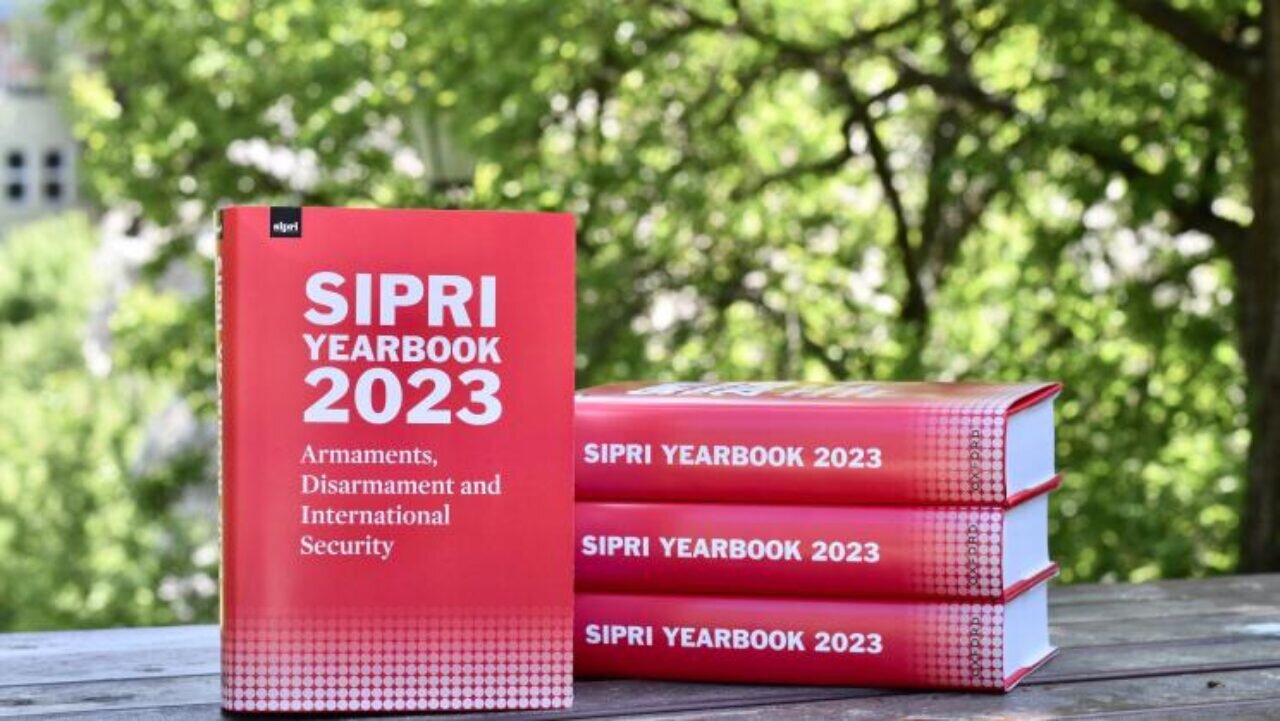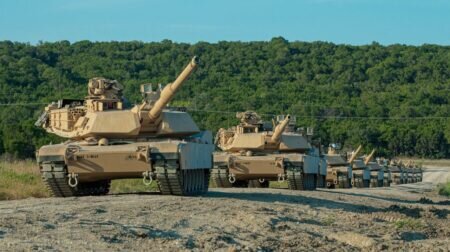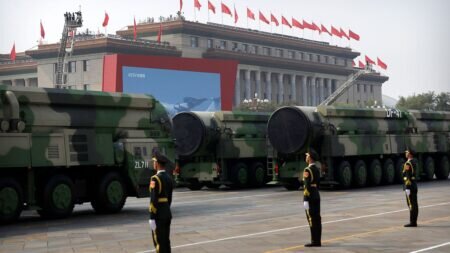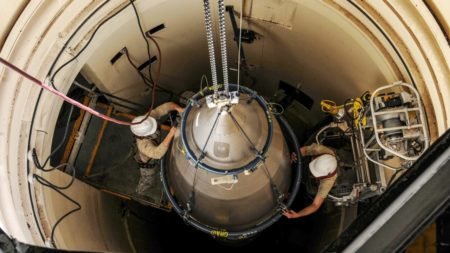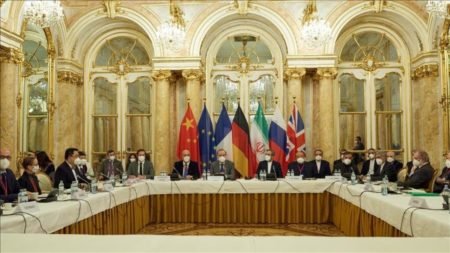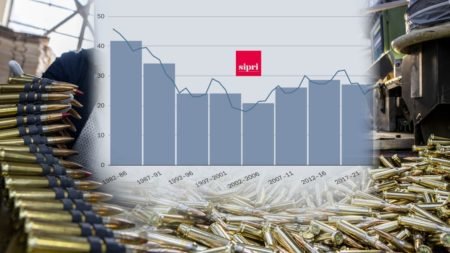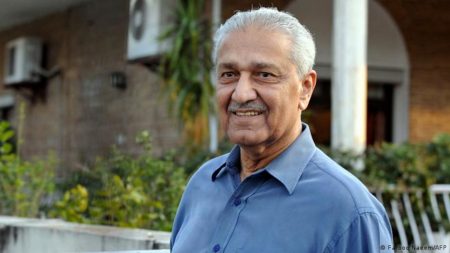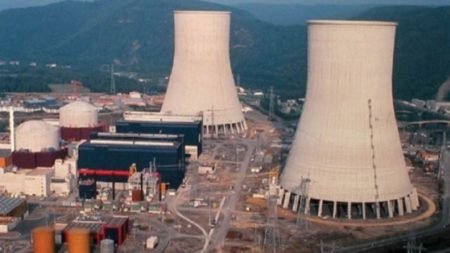The Stockholm International Peace Research Institute (SIPRI) today launches its annual assessment of the state of armaments, disarmament and international security.
A key finding of SIPRI Yearbook 2023 is that the number of operational nuclear weapons started to rise as countries’ long-term force modernization and expansion plans progressed.
Nuclear arsenals being fortified around the world
The nine nuclear-armed states—the United States, Russia, the United Kingdom, France, China, India, Pakistan, the Democratic People’s Republic of Korea (North Korea) and Israel—continue to modernize their nuclear arsenals and several deployed new nuclear-armed or nuclear-capable weapon systems in 2022.
Of the total global inventory of an estimated 12 512 warheads in January 2023, about 9576 were in military stockpiles for potential use—86 more than in January 2022 (see the table below). Of those, an estimated 3844 warheads were deployed with missiles and aircraft, and around 2000—nearly all of which belonged to Russia or the USA—were kept in a state of high operational alert, meaning that they were fitted to missiles or held at airbases hosting nuclear bombers.
Russia and the USA together possess almost 90 per cent of all nuclear weapons. The sizes of their respective nuclear arsenals (i.e. useable warheads) seem to have remained relatively stable in 2022, although transparency regarding nuclear forces declined in both countries in the wake of Russia’s invasion of Ukraine in February 2022.
In addition to their useable nuclear weapons, Russia and the USA each hold more than 1000 warheads previously retired from military service, which they are gradually dismantling.
SIPRI’s estimate of the size of China’s nuclear arsenal increased from 350 warheads in January 2022 to 410 in January 2023, and it is expected to keep growing. Depending on how it decides to structure its forces, China could potentially have at least as many intercontinental ballistic missiles (ICBMs) as either the USA or Russia by the turn of the decade.
‘China has started a significant expansion of its nuclear arsenal,’ says Hans M. Kristensen, Associate Senior Fellow with SIPRI’s Weapons of Mass Destruction Programme and Director of the Nuclear Information Project at the Federation of American Scientists (FAS). ‘It is increasingly difficult to square this trend with China’s declared aim of having only the minimum nuclear forces needed to maintain its national security.’
Although the UK is not thought to have increased its nuclear weapon arsenal in 2022, the warhead stockpile is expected to grow in the future as a result of the British government’s announcement in 2021 that it was raising its limit from 225 to 260 warheads. The government also said it would no longer publicly disclose its quantities of nuclear weapons, deployed warheads or deployed missiles.
In 2022 France continued its programmes to develop a third-generation nuclear-powered ballistic missile submarine (SSBN) and a new air-launched cruise missile, as well as to refurbish and upgrade existing systems.
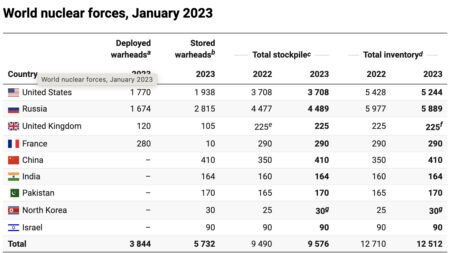
North Korea continues to prioritize its military nuclear programme as a central element of its national security strategy. While North Korea conducted no nuclear test explosions in 2022, it conducted more than 90 tests of missiles. Some of these missiles, which include new ICBMs, may be capable of carrying nuclear warheads. SIPRI estimates that the country has now assembled around 30 warheads and possesses enough fissile material for a total of 50–70 warheads, both significant increases over the estimates for January 2022.
Israel—which does not publicly acknowledge possessing nuclear weapons—is also believed to be modernizing its nuclear arsenal.
‘Most of the nuclear-armed states are hardening their rhetoric about the importance of nuclear weapons, and some are even issuing explicit or implicit threats about potentially using them,’ said Matt Korda, Associate Researcher with SIPRI’s Weapons of Mass Destruction Programme and Senior Research Associate with the FAS Nuclear Information Project. ‘This elevated nuclear competition has dramatically increased the risk that nuclear weapons might be used in anger for the first time since World War II.’
‘With billion-dollar programmes to modernize, and in some cases expand, nuclear arsenals, the five nuclear weapon states recognized by the Nuclear Non-Proliferation Treaty seem to be moving further and further from their commitment to disarmament under the treaty,’ said Wilfred Wan, Director of SIPRI’s Weapons of Mass Destruction Programme.
Nuclear diplomacy dealt a further blow by Russia’s invasion of Ukraine
Nuclear arms control and disarmament diplomacy suffered major setbacks following Russia’s full-scale invasion of Ukraine in February 2022. In the wake of the invasion, the USA suspended its bilateral strategic stability dialogue with Russia. In February 2023 Russia announced it was suspending its participation in the 2010 Treaty on Measures for the Further Reduction and Limitation of Strategic Offensive Arms (New START)—the last remaining nuclear arms control treaty limiting Russian and US strategic nuclear forces. Talks about a follow-on treaty to New START, which expires in 2026, were also suspended. Nevertheless, by SIPRI’s assessment, both countries’ deployed strategic nuclear forces remained within the New START limits as of January 2023.
Iran’s military support to Russian forces in Ukraine and the political situation in Iran also overshadowed talks on reviving the Joint Comprehensive Plan of Action (JCPOA), the 2015 agreement meant to prevent Iran from developing nuclear weapons. The JCPOA’s revival now seems increasingly unlikely.
The USA and the UK both declined to release information to the public concerning their nuclear forces in 2022, which they had done in previous years.
‘In this period of high geopolitical tension and mistrust, with communication channels between nuclear-armed rivals closed or barely functioning, the risks of miscalculation, misunderstanding or accident are unacceptably high,’ says Dan Smith, SIPRI Director. ‘There is an urgent need to restore nuclear diplomacy and strengthen international controls on nuclear arms.’
Global security and stability in increasing peril
The 54th edition of the SIPRI Yearbook reveals the continuing deterioration of global security over the past year. The impacts of the war in Ukraine are visible in almost every aspect of the issues connected to armaments, disarmament and international security examined in the Yearbook. Nevertheless, it was far from being the only major conflict being waged in 2022, and acute geopolitical tensions, mistrust and division had been growing long before Russia’s full-scale invasion of its neighbour.
‘We are drifting into one of the most dangerous periods in human history,’ says Dan Smith, SIPRI Director. ‘It is imperative that the world’s governments find ways to cooperate in order to calm geopolitical tensions, slow arms races and deal with the worsening consequences of environmental breakdown and rising world hunger.’
In addition to the usual detailed coverage of nuclear arms control, disarmament and non-proliferation issues, the SIPRI Yearbook presents data and analysis on developments in world military expenditure, international arms transfers, arms production, multilateral peace operations, armed conflicts and more. Special sections in SIPRI Yearbook 2023 explore the rise of private military and security companies such as the Wagner Group, and the related impact on peace and security; how the war in Ukraine has affected governance of space and cyberspace; the attacks on nuclear power plants during the fighting in Ukraine, and their implications; and the regulation of new technologies such as autonomous weapon systems.

